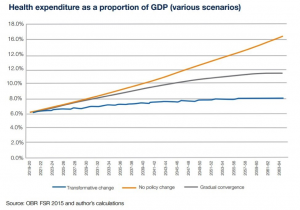New Report Reveals Seven Health Innovations Could Save The NHS £18.5 Billion, And The Social Care Sector £6.3 Billion Between 2015 – 2030
 A major new report from the International Longevity Centre – UK (ILC-UK), supported by EY has found that whilst the UK is well placed to innovate to improve health outcomes and reduce costs, the UK is often not doing enough with the tools at its disposal.
A major new report from the International Longevity Centre – UK (ILC-UK), supported by EY has found that whilst the UK is well placed to innovate to improve health outcomes and reduce costs, the UK is often not doing enough with the tools at its disposal.
With the NHS committed to achieving efficiency savings of £22 billion through productivity gains of 2-3% between 2015 – 2020, ‘Towards affordable healthcare: Why effective innovation is key’ explores how health care innovations currently employed at home and abroad could increase productivity and reduce costs.
The report showcases seven outstanding global and UK-based innovations with a strong evidence base of demonstrable success, and calculates the savings that could be achieved by implementing them across the UK. Home grown innovations include:
- The UK’s Memory First Project, an integrated dementia service run by a consortium of GPs across Staffordshire. Savings if working methods applied nationally: up to £38 million between 2019 – 2030.
- Manchester Royal Infirmary’s programme of providing the training and equipment to perform home dialysis. Savings if programmed applied nationally: up to £5.6 billion between 2014 – 2030.
The report concludes however that the UK is often not doing enough with the tools at its disposal to implement such innovations. Social care is underfunded and fragmented, which has consequences also for NHS costs, and funding mechanisms within the health system can often discourage innovation; there continues to be a slow uptake in the UK of new drugs and treatments, with adoption speed varying across the country.
The report presents three simple scenarios for future UK health care costs based on projections for demographic change, the rate of productivity growth in the economy, and the degree to which innovations are implemented, thus reducing residual costs, i.e. the impact of investment in technology, relative prices and different policies and institutional adaptations within the health service.
- Transformative change: The health service makes significant productivity gains and ensures that residual health care costs are zero over the projected period.
- Gradual convergence: In light of continuing cost pressures, it is perhaps hard to imagine public policymakers and individual NHS Trusts will not make adjustments over time to improve efficiency, but the transformation will take time and is unlikely to happen overnight. For this reason, productivity gradually improves over time so that residual health costs converge to zero by the end of the projected period (from 1.7% in 2019-20 to 0% by 2064-65).
- No policy change: There is no meaningful policy change, productivity in the health service continues to disappoint and residual health costs rise in line with the historic OECD average (1.7%)
Health spending as a proportion of GDP
- In the transformative change scenario, health spending rises from around 6% of GDP in 2019-20 to 8% by 2064-65.
- In the gradual convergence scenario, health spending rises from around 6% of GDP in 2019-20 to 11.4% by 2064-65.
- In the no policy change scenario, health spending rises from around 6% of GDP in 2019-20 to 16.4% by 2064-65.
The primary balance – the difference between non interest receipts and expenditure
- In the transformative change scenario, the primary balance falls from a surplus of around 2% of GDP to a deficit of 1.9%.
- In the gradual convergence scenario, the primary balance falls from a surplus of around 2% of GDP to a deficit of 5.3%.
- In the no policy change scenario, the primary balance falls from a surplus of around 2% of GDP to a deficit of 10.3%.
 Sally-Marie Bamford, Research and Strategy Director, ILC-UK said:
Sally-Marie Bamford, Research and Strategy Director, ILC-UK said:
‘Whilst the UK has a strong history of innovation in the field of healthcare, the UK is at a crossroads. We have world-leading higher education and research institutions, and some of the most cutting-edge health tech start-ups are emerging from the UK. However, social care has for too long played second fiddle to the NHS, and a financially unsustainable model of adult social care has a knock-on effect in terms of NHS sustainability.
Within the NHS, too many funding mechanisms still do not reward or encourage innovation, with payments too often based on output and not outcome, and Clinical Commissioning Group funding regulations discouraging the bold moves needed to create long-term cost savings, whilst still maintaining high levels of quality.
As one of the largest components of age-related public spending, healthcare is at the forefront of the challenge of ageing. ‘Towards affordable healthcare: Why effective innovation is key’ demonstrates why supporting long run productivity growth in healthcare is likely to be one, if not the, most important element in ensuring a sustainable older society’.
Shaun Crawford, Global Insurance Leader, EY:
‘In undertaking this research, it became very apparent that the UK has a wealth of entrepreneurial expertise in digital innovation that encompasses ‘HealthTech’ and ‘InsurTech’.
It would seem highly desirable for the UK Government to fully leverage and indeed promote existing UK innovation to solve both many of the NHS’s challenges and showcase UK expertise in a post-Brexit international market.
It was particularly rewarding to see the tangible benefits already generated by the NHS’s own adoption of some of this innovation in our health and social care issues. We can clearly see the advantages that could be leveraged by other global economies facing even more significant health and ageing challenges than the UK’.





